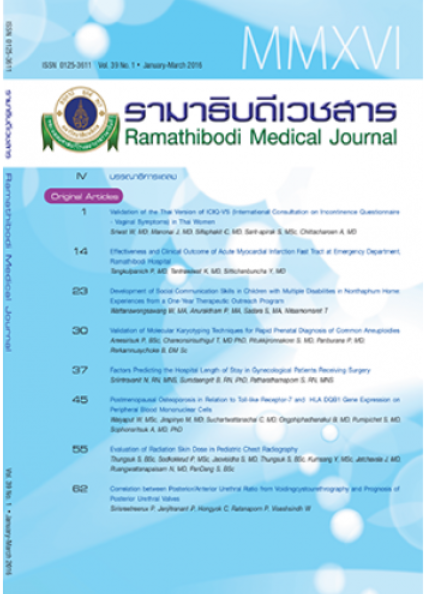Effectiveness and Clinical Outcome of Acute Myocardial Infarction Fast Tract: Emergency Department, Ramathibodi Hospital
Keywords:
Acute myocardial infarctionAbstract
Purpose & Method: Time is crucial for acute coronary syndrome (ACS) patients which is the main purpose of Acute Myocardial Infarction (AMI) fast tract development for early diagnosis and reperfusion therapy at Ramathibodi Hospital since 2010.Thus, using a retrospective chart review approach of patients who had been participated in AMI fast tract in emergency department at Ramathibodi Hospital during 2012 – 2014. this study aimed to evaluate the performance on ACS treatment based on international standards.
Result: 811 from 2000 patients with ischemic-like symptom who enrolled AMI fast tract had chest pain cause by non-cardiac cause (eg. gastroesophageal reflux disease, muscle strain) (n = 255, 31.44%), followed by non –ST-segment elevation myocardial infarction (NSTEMI) (n = 147, 18.1%), unstable angina (n = 112, 13.8.5%), Stable angina (n = 83, 10.2%), and ST-segment elevation myocardial infarction STEMI (n = 58, 7.15%). In this studied group, 88.5% who had performed ECG within 10 minutes had the annually average door-to-ECG time decreased to 17 (16), 6 (
7) and 5 (
0.06) minutes from 2012 to 2014, respectively. For STEMI patients, 88.5% (n = 50) received primary percutaneous intervention (PCI) for reperfusion therapy which 71.92% (n = 41) was performed within 90 minutes. The average door-to-balloon time was reduced from 95.01 (
41.79) minutes in 2013 to 83.58 (
37.19) minutes in 2014.
Conclusion: AMI fast tract is very effective based on American College of Cardiology/American Heart Association (ACC/AHA) and European Society of Cardiology (ESC).
References
Schull MJ, Morrison LJ, Vermeulen M, Redelmeier DA. Emergency department gridlock and out-of-hospital delays for cardiac patients. Acad Emerg Med. 2003;10(7):709-16.
Olshaker JS, Rathlev NK. Emergency Department overcrowding and ambulance diversion: the impact and potential solutions of extended boarding of admitted patients in the Emergency Department. J Emerg Med. 2006;30(3):351-6.
Srimahachota S, Boonyaratavej S, Kanjanavanit R, et al. Thai Registry in Acute Coronary Syndrome (TRACS)--an extension of Thai Acute Coronary Syndrome registry (TACS) group: lower in-hospital but still high mortality at one-year. J Med Assoc Thai. 2012;95(4):508-18.
McNamara RL, Wang Y, Herrin J, et al. Effect of door-to-balloon time on mortality in patients with ST-segment elevation myocardial infarction. J Am Coll Cardiol. 2006;47(11):2180-6.
O'Gara PT, Kushner FG, Ascheim DD, et al. 2013 ACCF/AHA guideline for the management of ST-elevation myocardial infarction: executive summary: a report of the American College of Cardiology Foundation/American Heart Association Task Force on Practice Guidelines: developed in collaboration with the American College of Emergency Physicians and Society for Cardiovascular Angiography and Interventions. Catheter Cardiovasc Interv. 2013 Jul 1;82(1):E1-27. doi:10.1002/ccd.24776.
Steg PG, James SK, Atar D, et al. ESC Guidelines for the management of acute myocardial infarction in patients presenting with ST-segment elevation. Eur Heart J. 2012 Oct;33(20):2569-619. doi:10.1093/eurheartj/ehs215.
Tungsubutra W, Tresukosol D, Krittayaphong R, Panchavinnin P, Chotnaiwattarakul C, Phankingtongkhum R. Acute coronary syndrome in 1366 patients at Siriraj Hospital: clinical characteristics, management and in-hospital outcomes. J Med Assoc Thai. 2007;90 Suppl 2:25-32.
Tantisiriwat W, Jiar W, Ngamkasem H, Tantisiriwat S. Clinical outcomes of fast track managed care system for acute ST elevation myocardial infarction (STEMI) patients: Chonburi Hospital experience. J Med Assoc Thai. 2008;91(6):822-7.
Pan MW1, Chen SY, Chen CC, et al. Implementation of multiple strategies for improved door-to-balloon time in patients with ST-segment elevation myocardial infarction. Heart Vessels. 2014 Mar;29(2):142-8. doi:10.1007/s00380-013-0336-z.
Chua SK, Cheng JJ, Shyu KG, et al. Improvement in door-to-balloon (D2B) time in acute ST-elevation myocardial infarction through the D2B alliance--experience of 15 primary percutaneous coronary intervention centers in Taiwan. Circ J. 2013;77(2):383-9.
Coyne CJ, Testa N, Desai S, et al. Improving door-to-balloon time by decreasing door-to-ECG time for walk-in STEMI patients. West J Emerg Med. 2015;16(1):184-9. doi:10.5811/westjem.2014.10.23277.
Downloads
How to Cite
Issue
Section
License
Copyright (c) 2016 By the authors. Licensee RMJ, Faculty of Medicine Ramathibodi Hospital, Mahidol University, Bangkok, Thailand

This work is licensed under a Creative Commons Attribution-NonCommercial-NoDerivatives 4.0 International License.













